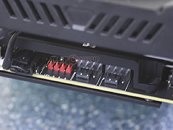Wednesday, September 26th 2018

ASUS Clears the Air on Missing Fan Connect Case-Fan Headers on GeForce RTX 2080 Ti STRIX
ASUS ROG Fan Connect is a feature that allows you to connect up to two of your case-fans to two standard 4-pin PWM fan headers present on an ASUS ROG Strix series graphics card, letting you synchronize your case's front intake and rear exhaust fans to the temperature of the GPU, and control them using the GPUTweak software. ASUS has introduced the feature with the Pascal and Vega architecture, and has since included it with its ROG Strix series graphics cards.
When we published our reviews of the ASUS ROG Strix GeForce RTX 2080 Ti and its sibling based on the RTX 2080, we noticed something curious, and our readers were quick to spot it as well. ASUS did not add the Fan Connect 4-pin PWM case-fan headers on its GeForce RTX 2080 Ti Strix card, while the company's RTX 2080 card had them. Adding to the confusion, the PCB of our review sample had blank traces where the headers are supposed to be. This got our readers asking if the final product has those headers. The box doesn't advertise those headers anywhere, neither does the ASUS website, so it isn't a case of false-marketing yet.We reached out to ASUS to clarify about this issue. ASUS, in its response, stated that while the RTX 2080 Ti Strix PCB does feature traces for these headers and related SMT components, they decided not to implement the feature in the initial RTX 2080 Ti production batch, because the designers ran into "technical problems." The company stated that all future production batches will include this feature. To avoid having to mark the cards with headers in future batches leading to consumer-confusion, ASUS decided to omit mentions of fan headers throughout its marketing material for the cards. You won't find any mention of the headers (or lack thereof) on either the boxes, or the product-pages on ASUS website, or any other marketing material.
When we published our reviews of the ASUS ROG Strix GeForce RTX 2080 Ti and its sibling based on the RTX 2080, we noticed something curious, and our readers were quick to spot it as well. ASUS did not add the Fan Connect 4-pin PWM case-fan headers on its GeForce RTX 2080 Ti Strix card, while the company's RTX 2080 card had them. Adding to the confusion, the PCB of our review sample had blank traces where the headers are supposed to be. This got our readers asking if the final product has those headers. The box doesn't advertise those headers anywhere, neither does the ASUS website, so it isn't a case of false-marketing yet.We reached out to ASUS to clarify about this issue. ASUS, in its response, stated that while the RTX 2080 Ti Strix PCB does feature traces for these headers and related SMT components, they decided not to implement the feature in the initial RTX 2080 Ti production batch, because the designers ran into "technical problems." The company stated that all future production batches will include this feature. To avoid having to mark the cards with headers in future batches leading to consumer-confusion, ASUS decided to omit mentions of fan headers throughout its marketing material for the cards. You won't find any mention of the headers (or lack thereof) on either the boxes, or the product-pages on ASUS website, or any other marketing material.



35 Comments on ASUS Clears the Air on Missing Fan Connect Case-Fan Headers on GeForce RTX 2080 Ti STRIX
The Ray tracing was bullshit, lets all be honest, but the speed of the card itself is great and having jumped from a Strix 1080ti to a Strix 2080ti I am seeing between 25-35% increases depending on the application/game.
The bitterest most toxic posts come from those who simply cannot afford the card, that is the reality, because anyone who can afford one and has bought one will be happy with them, the odd early batch artefact issue aside - all of whom would have had new cards.
My card overclocks to 1815mhz and 14800 on the memory, just shy of the level the Matrix version does (slightly higher) the Strix is a blistering card, looks nicer than the matrix I think and oozes quality - though it should for the price.
Nvidia do have a case to answer for the lack of ray tracing titles and my guess is the 3000 series will be the cards that shine with ray tracing.
Time will tell